|
August 3 Turf & Ornamentals Field Day, Wichita
The field day program is designed for all segments of the turf industry - lawn care, athletic fields, golf courses, and grounds maintenance. Included on the program are research presentations, problem diagnosis, commercial exhibitors, and equipment displays. There will be time to see current research, talk to the experts and get answers to your questions. Pesticide recertification is available in 3A & 3B, as well as GCSAA education points. For more information and to register, go to: http://www.kansasturfgrassfoundation.com/annual-ktf-field-day.html 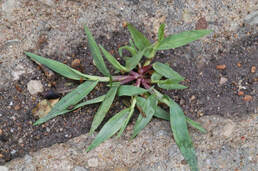 This is the time of year when people really notice crabgrass infestations. By far the best way to control crabgrass is to prevent it by maintaining a good, thick lawn. Crabgrass is an annual that must come up from seed each year and the seed must have light in order to germinate. If a lawn is thick enough that sunlight does not reach the soil, the crabgrass will not germinate. Under Kansas conditions it is not easy to maintain such a lawn; so many gardeners do the next best thing and apply a crabgrass preventer in the spring. Crabgrass preventers kill the seed as it germinates. Most do not have any effect on crabgrass that has already come up. If we are too late to apply a preventer, we do have other herbicides that will kill crabgrass after it is up including Ortho Weed-B-Gon Max + Crabgrass Control, Bayer All-in-One Lawn Weed and Crabgrass Killer and Fertilome Weed Out with Crabgrass Killer. Each contains quinclorac, which is a crabgrass herbicide, as well as other active ingredients that control broadleaf weeds. Quiclorac is an excellent crabgrass killer that controls not only crabgrass but also has good activity on foxtail and certain broadleaves such as field bindweed, black medic and clover. However, it does little to nothing to goosegrass. However, quinclorac can harm garden plants if clippings are used as mulch. Clippings should be returned to the lawn or discarded. Even composting will not break down the quinclorac. Fortunately, crabgrass starts declining about the middle of August. This is about the same time that cool- season grasses such as tall fescue and Kentucky bluegrass start to come out of their summer doldrums. By the first of September, the crabgrass will be less noticeable. Therefore, a small infestation is best ignored. Remember that crabgrass is a warm-season annual and will be killed by the first frost. (Ward Upham) The weather this summer has resulted in many peonies catching the "measles" and/or powdery mildew.
Measles: Measles is a disease, also known as red spot, that causes distinct, reddish-purple spots on the upper leaf surfaces. These spots often coalesce and become large, reddish purple blotches on the upper leaf surfaces but are a light brown color when viewed from the underside of the leaves. The spots on stems will merge and form streaks that are reddish brown. Powdery Mildew: Plants infected with powdery mildew look like they have been dusted with flour and can lead to death of the leaves. This disease is more rare in Kansas than Measles but does show up in wet, humid summers. Sanitation is the best control for both these diseases. Remove all diseased tissue, including stems, at the end of the growing season. Actually, the foliage can be removed in mid-August with no harm to the plants as the plants will be essentially dormant. Foliage that has already died should be removed now. Mulch that contains plant debris should also be discarded and then replaced with fresh mulch. Reducing the source of the inoculum will reduce the chances of another severe outbreak next year. (Ward Upham) 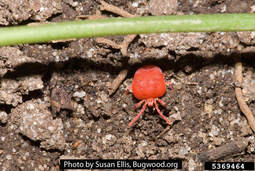 Chiggers are mites, not insects. And like all mites, the adults have eight legs. However, the larva only has six legs. Though the bright red female adult is tiny (about 1/20th of an inch) the larva is much smaller (about 1/150th of an inch). Only the larvae are parasitic and attack animals. The larva injects digestive juices into the skin, which causes a rapid swelling. In the center of the swelling is a "feeding tube" from which the chigger sucks out liquefied skin cells. Feeding usually continues for 2 to 4 days. Protection from chiggers uses two approaches. The use of a repellent can discourage chiggers from attacking. The most effective repellents are Deet and permethrin. Both are applied to clothing. The second approach seeks to reduce chigger populations. Keeping the lawn mowed regularly can help, but large populations may require the use of an acaricide. Effective products include bifenthrin (Talstar, Hi-Yield Bug Blaster II, Hi-Yield Bug Blaster Bifenthrin, and Ortho Lawn Insect Killer Granules), cyfluthrin (Tempo 20, Bayer Vegetable & Garden Insect Spray) and carbaryl (Sevin). For more information, see the K-State Research and Extension publication titled, “Chiggers” at: http://www.ksre.ksu.edu/bookstore/pubs/MF2107.PDF (Ward Upham) 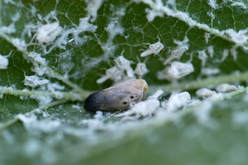 These small, hopping insects are causing concern among gardeners because they are so noticeable. What people often see first is not the insect but the filaments of white, wool-like wax they leave behind. Nymphs are also coated with this white, powdery wax but adults of the species I've observed are more of a grayish color with a darker rear end. Only the adults have wings that are held over the body like a pup tent. Nymphs are more flattened and may not appear to be insects at first because of the waxy coating. Plant injury due to these insects is usually minor. Feeding by large populations may cause death of seedlings or wilting of small twigs of larger plants. Control is usually not recommended because natural enemies often keep flatid planthoppers in check. If control is warranted, a strong stream of water from a hose should knock them off or a number of insecticides may be used including malathion, permethrin, cyfluthrin, and bifenthrin. For a detailed description, check out the University of Georgia Bugwood page at http://wiki.bugwood.org/Archive:Ash/Flatid_Planthoppers (Ward Upham) 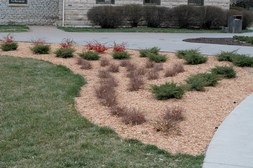 With many municipalities and tree service companies having wood chippers, gardeners often are able to get chips free. We are sometimes asked our opinion about whether these make a good mulch. Some people have heard that these chips will tie up nitrogen so that the garden plants won't grow as well. If wood chips are used as a mulch, there is no cause for concern. However, if the chips are mixed with the soil, there can be a problem during the breakdown process. The microorganisms that break down the chips need a certain amount of nitrogen during the process. With most green material, there is enough nitrogen in the material itself to meet the needs of the microorganisms. However, if nitrogen levels in wood chips are so low, the microorganisms must borrow it from the surrounding soil. This results in less nitrogen being available to the plants. However, when the raw organic material has been digested, the microorganisms die and release the nitrogen. Therefore, the nitrogen is not lost but is simply unavailable for plant use for a period of time. Again, this is only a concern if the wood chips are mixed into the soil. There is no problem with nitrogen tie-up if the chips are used as a mulch. However, two other points should be kept in mind. These chips can be used by foraging termites as a bridge to homes and other structures. Termites are light and heat sensitive and will not bother the chips themselves if they are 3 inches deep or less. Therefore, watch the depth of these chips near the house or other buildings. Also leave a bare area several inches wide next to the house so that any termite activity is noticeable. The second concern regards mulching trees. Do not mound mulch around the trunk of the tree as it can damage it. Leave a few inches of bare soil so the trunk can remain dry. (Ward Upham) 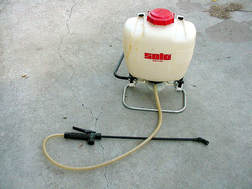 We sometimes receive complaints from homeowners regarding the lack of effectiveness of various pesticides. There can be a number of reasons for this lack of efficacy. Here are some of the common ones: 1. Lack of good foliage penetration. This often is a problem when spraying for bagworms on junipers. The spray must penetrate the foliage and reach the bagworms toward the inside of the plant. High-pressure commercial sprayers are able to get the spray to the insects but homeowner models are much more problematic. With pump-up sprayers, you may have to push the wand through the outer layer of foliage to reach insects toward the inside of the plant. 2. Not spraying where the insect is. Many of our insects and mites feed on the underside of leaves. If the plants are sprayed over the top, little to no pesticide reaches the pests. This problem is often seen with spider mites on broadleaf plants and cabbage worms on cabbage, broccoli and cauliflower. 3. Maturity of pest. Insects become much more difficult to control when they become adults. For example, Sevin does a good job of controlling young, early instar grasshoppers but is much less effective on adults. 4. Level of disease pressure. Most fungicides are better used as preventatives than as curatives. If a disease gets firmly established, it may be difficult to bring it back under control. For example, chlorothalonil is effective in controlling early blight and Septoria leaf spot on tomato if used as a preventative. However, chlorothalonil will not control these diseases on badly infested plants. 5. Choosing the wrong product. Homeowners often use a product they have on hand. However, products differ markedly in how well they control specific pests. Make sure the pest you wish to control is on the label. Unfortunately, even labeled products may vary in effectiveness. Check K-State Research and Extension recommendations for products. 6. Using the wrong rate. Using less than recommended rate can reduce effectiveness but using more can also cause problems. For example, using a systemic herbicide such as Roundup at higher than recommended rates can burn off the top of the plant before the herbicide is translocated to the roots, thereby reducing effectiveness. 7. High pH spray water. Certain pesticides are not stable in high or low pH water. Following are some examples. * Captan has a half-life of 3 hours at a pH of 7.0, but only 10 minutes at a pH of 8.0. * Carbaryl (Sevin) has a half-life of 24 days at pH 7.0, but only 1 day at pH 9. The half-life of a product is the amount of time it takes for half of the product to be neutralized. For example, if you apply 3 ounces of a product to a gallon of water and the half-life is 8 hours, only half of the product is still active at 8 hours, one-fourth of the product is active 16 hours and 1/8 of the product is still active at 24 hours. (Ward Upham) July 29 Open House, K-State Research & Extension Center, Olathe
http://www.johnson.k-state.edu/lawn-garden/horticulture-field-day.html Come see the hottest and newest plants while enjoying cool classes in air-conditioned comfort and ice cold water while wandering the field trials. Learn about the latest and greatest before it ever hits the garden centers. It's all here at the K-State Research and Extension Horticulture Center’s Field Day. It's your chance to peek behind the scenes, talk with the experts and learn about the latest varieties and methods for achieving growing success. This year we are celebrating 20 years of the research center in its current location. Admission is $5 per person, which includes ice cold bottled water, seminars, classes and demonstrations. K-State Research and Extension horticulture research develops its list of recommended grasses, flowers or vegetable varieties through university research conducted in Olathe to determine what grows best in our landscapes. August 3 Turf & Ornamentals Field Day, Wichita The field day program is designed for all segments of the turf industry - lawn care, athletic fields, golf courses, and grounds maintenance. Included on the program are research presentations, problem diagnosis, commercial exhibitors, and equipment displays. There will be time to see current research, talk to the experts and get answers to your questions. Pesticide recertification is available in 3A & 3B, as well as GCSAA education points. For more information and to register, go to: http://www.kansasturfgrassfoundation.com/annual-ktf-field-day.html |
AuthorsCynthia Domenghini runs the Horticulture Response Center in the Department of Horticulture and Natural Resources at Kansas State University. Other contributors include K-State Extension Specialists. Archives
March 2024
Categories
All
|
| K-State Research and Extension Horticulture Newsletter |
|
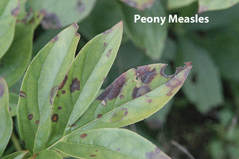
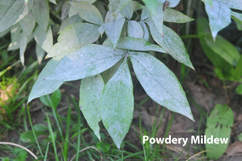
 RSS Feed
RSS Feed
